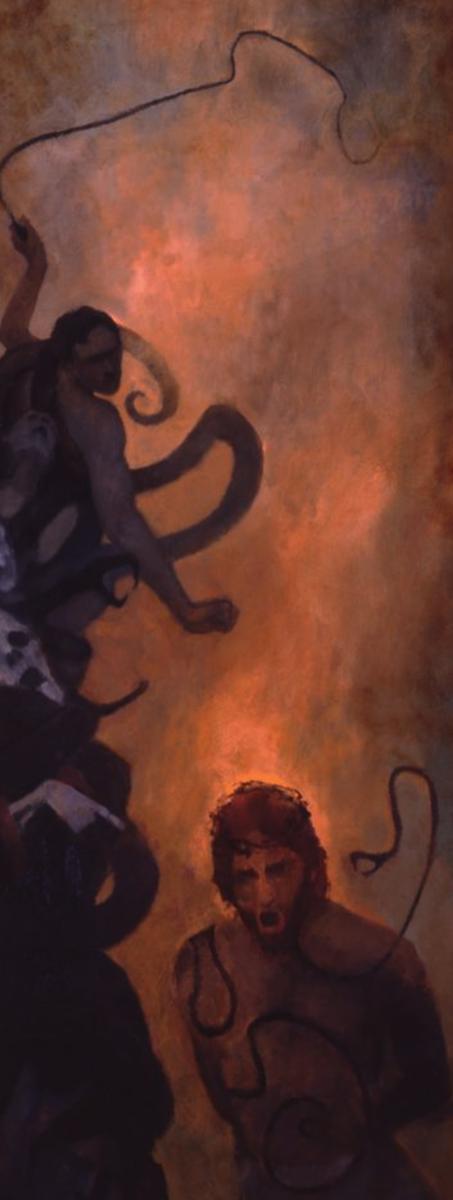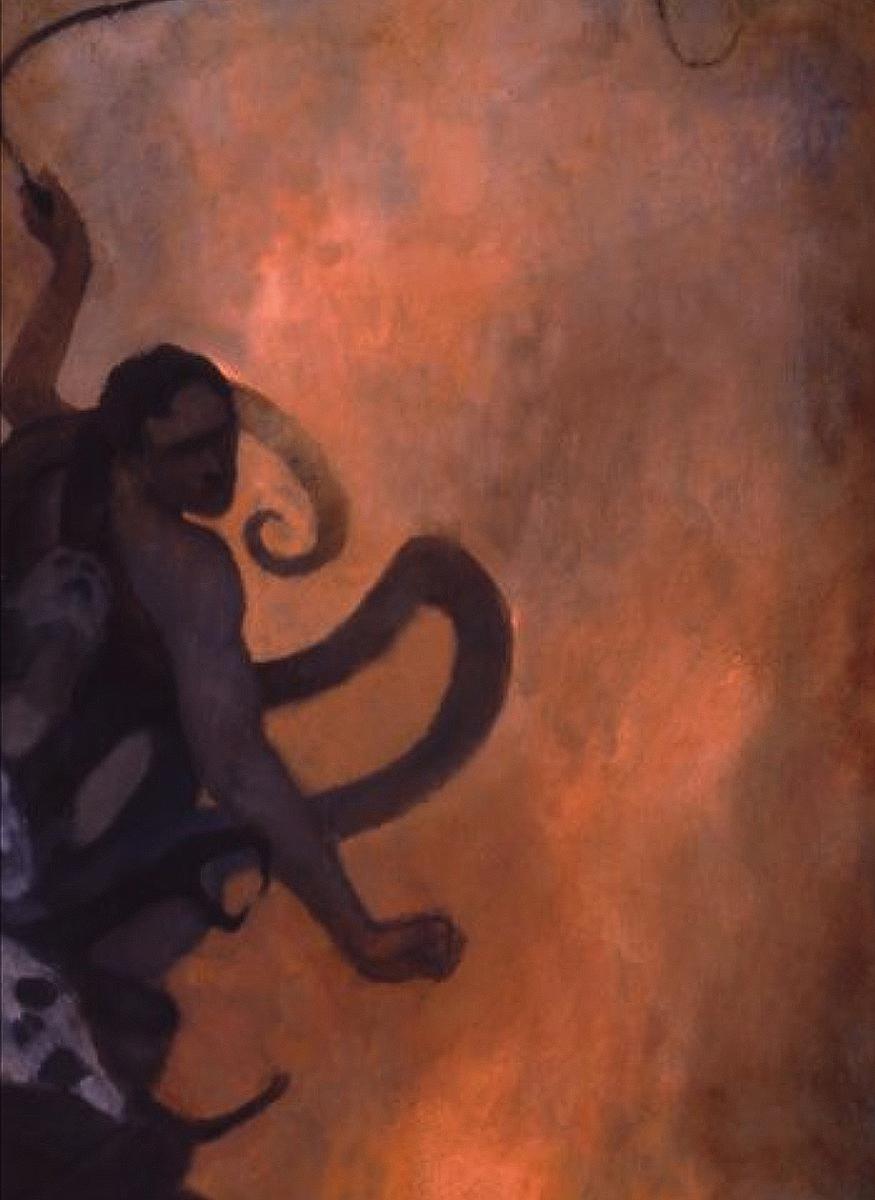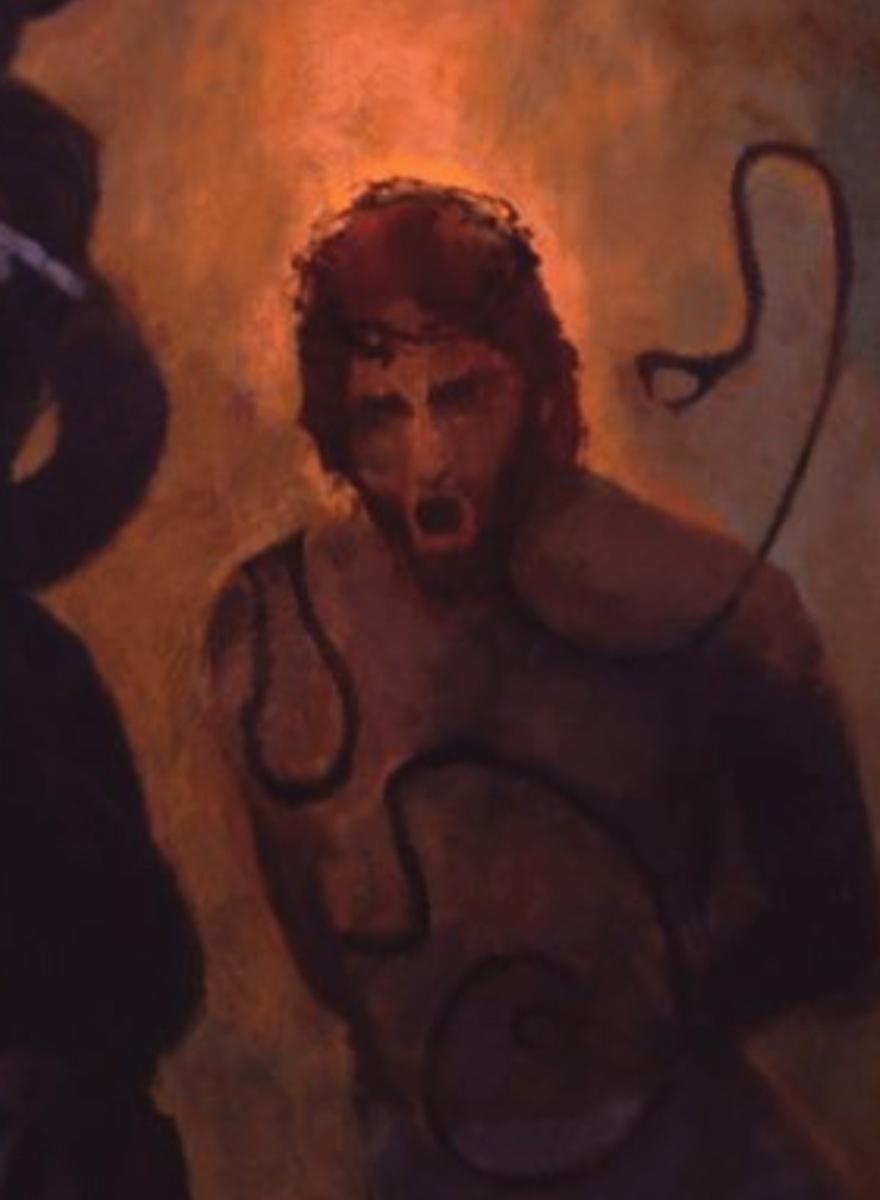April 11: The Scourging of Christ
♫ Music:
Note: Music for the day starts very quietly.
Day 41 - Monday, April 11
Title: THE SCOURGING OF CHRIST
Scripture: Psalm 129:1- 4
“Many a time they have afflicted me from my youth,”
Let Israel now say—
“Many a time they have afflicted me from my youth;
Yet they have not prevailed against me.
The plowers plowed on my back;
They made their furrows long.”
The Lord is righteous;
He has cut in pieces the cords of the wicked.
Poetry:
Simon the Cyrenian Speaks
by Countee Cullen
He never spoke a word to me,
And yet He called my name;
He never gave a sign to me,
And yet I knew and came.
At first I said, "I will not bear
His cross upon my back;
He only seeks to place it there
Because my skin is black."
But He was dying for a dream,
And He was very meek,
And in His eyes there shone a gleam
Men journey far to seek.
It was Himself my pity bought;
I did for Christ alone
What all of Rome could not have wrought
With bruise of lash or stone.
THE SCOURGING OF CHRIST
Why the suffering? Why the affliction? Surely, this is the story of Scripture. Adam and Eve, exiled and the childless. Joseph, betrayed by his family, and in prison among foreigners. Samson, eyes gouged out, toiling for Philistines. Jonah, deep under the waves, and then under the scorching sun. David, fleeing from Saul and later his own son. Job, handed over to Satan. The life of Israel, the life of the heroes of the faith, is a life of affliction from youth. All of them can say: “many times they have afflicted me from my youth.” Is being the chosen people of God a blessing, a favoritism, a privilege? Yes. And No. A blessing to be bound up in the history of God. And the curse of affliction from youth.
And what stands behind this? Job lifts the veil—the work of Satan, the prince of the power of the air (Eph. 2:2). Who stands behind the suffering of Job? Whose work is bound up with the rising, falling and actions of the nations? And who stands behind the suffering of Jesus? The answer is one and the same: Satan, who after he had tempted Jesus, left him until a more opportune time (Luke 4:13).
But the suffering, and the powers that stand behind it, powers that add layers to these dynamics without in the least exonerating us—these we may be used to.
The hardest part of our Psalm is not the affliction, but the claim that the Lord is righteous, that he has “cut in pieces the cords of the wicked.” This is hard to see. Hard to see in the lives of Abraham, Isaac, and Jacob, who never saw the promised land. Hard to see in Moses, who saw but didn’t enter it. Hard to see in David and Solomon, whose reigns began so well, but ended in such tragedy. Hard to see in the agonies and sufferings of the prophets.
Here too, we live by faith. God does indeed cut the cords of the wicked, will indeed crush the head of the serpent. But as Abraham, Isaac, and Jacob lived in the hope of a promised land, so we live in the hope of the resurrection, tasting that the Lord is good, but awaiting that full revelation. For now, more often than not, we take up our crosses daily, and perhaps more often than not, its accompanying afflictions. For in this too, the Lord is good.
Prayer
Father, in the midst of the fear, anxiety and real suffering,
We await, we long for, the power of your resurrection.
Come soon, Lord. Come soon.
Amen
Dr. Adam Johnson
Associate Professor of Theology
Torrey Honors College
Biola University
For more information about the artwork, music, and poetry selected for this day, we have provided resources under the “About” tab located next to the “Devotional” tab.
About the Artwork:
The Flagellation of Christ
J. Kirk Richards
2007
Oil on canvas
59 x 25 in.
Private Collection
Flagellation at the hands of the Romans is mentioned in three of the four Gospels and was the usual prelude to crucifixion under Roman law. The practice was especially cruel and subjected the victim to flogging or whipping with implements such as whips, straps, lashes, rods, staffs, switches, chains, and, finally, the flagrum and flagellum (scourge). Because of its brutality, this punishment produced deep wounds and could even lead to death. Artist J. Kirk Richards paints The Flagellation of Christ with a shallow depth of field filled only with the figure of Christ and a column stacked with figures of his tormentors entangled within the coils of a large serpent or snake. The top figure exacts punishment on Christ with a lithe whip that transforms into a menacing snake wrapping around his body. This snake hints that the evil that fed those who punished Christ exacted a terrible price upon them—leaving them in the cold embrace of torment and death.
https://en.wikipedia.org/wiki/Flagellation
About the Artist
J. Kirk Richards is a favorite among admirers of contemporary spiritual artwork. His love of the textural, the poetic, and the mysterious has translated into a unique take on traditional Judeo-Christian themes. Richards attributes much of his love for the arts to an early emphasis on musical training in his parents’ home. Turning then from music to visual arts, Kirk studied with painters Clayton Williams, Patrick Devonas, Gary and Jennifer Barton, James Christensen, Joe Ostraff, and others. Two years in Rome influenced Richards’ palette, which often consists of subdued browns and rusts. Historical influences upon his art include Bastien-Lepage, Dagnan-Bouveret, Gustav Klimt, Edgar Maxence, Carl Bloch, Rembrandt, and Georges de La Tour. Kirk is best known for his contributions to the BYU Museum of Art exhibit Beholding Salvation: The Life of Christ in Word and Image. Kirk and his wife, Amy, have four creative children. They split their time between their home in Woodland Hills, California, and their country studio in the small town of Redmond, Utah. Richards’ work is mostly found in private collections throughout the country.
http://www.jkirkrichards.com/
About the Music:
“Tenebrae #2” from the album Golijov: Oceana, Tenebrae, 3 Songs
About the Performers:
The Kronos Quartet is an American string quartet based in San Francisco, California. They have been in existence with a rotating membership of musicians for over forty years. The quartet covers a very broad range of musical genres, including Mexican folk, experimental, pre-classical early music, movie soundtracks, jazz and tango, as well as contemporary classical music. More than nine hundred works have been written for them. Violinist David Harrington from Seattle, Washington, founded the quartet in 1973. With almost forty studio albums to their credit and having performed worldwide, they have been called "probably the most famous 'new music' group in the world," and have been praised in philosophical studies of music for the inclusiveness of their repertoire. They have worked with many minimalist composers, including John Adams, Arvo Pärt, George Crumb, Henryk Górecki, Steve Reich, Philip Glass, Terry Riley, and Kevin Volans.
https://kronosquartet.org/
About the Composer:
Osvaldo Golijov (b. 1969) grew up in an Eastern European Jewish home in La Plata, Argentina. He studied composition at the Jerusalem Rubin Academy in Israel, immersing himself in the musical traditions of the Holy Land. Golijov moved to the United States in 1986 to study with avant-garde composer George Crumb. In 1991 Golijov joined the faculty of the College of the Holy Cross in Worcester, Massachusetts, where he was named Loyola Professor of Music in 2007. In 2000, the premiere of his St. Mark Passion took the music world by storm. Commissioned by Helmuth Rilling for the European Music Festival, to commemorate the 250th anniversary of Bach’s death, the piece is a powerfully visceral retelling of the passion of Christ according to the Gospel of Mark. Critic Greg Sandow reports, “It rolls with the beat of Cuban and Brazilian percussion, blended with gutsy Latin singing by a Brazilian soloist and a chorus from Venezuela. There’s also Afro-Cuban dancing, classical singing by soprano Dawn Upshaw, a brass section that sounds like a Latin big band, and classical instruments, mostly cellos and violins, textured so that they sound both earthy and earthly.” Golijov had a long working relationship with soprano Dawn Upshaw, whom he called his muse. She premiered some of his works, often written specifically for her. These included Three Songs for Soprano and Orchestra and his popular opera, Ainadamar, which premiered in 2003. Starting in 2000, Golijov composed movie soundtracks for documentaries and other films, including The Man Who Cried, Youth Without Youth, Tetro, and Twixt. He has also composed and arranged chamber music, including for the Kronos Quartet and the St. Lawrence String Quartet.
https://osvaldogolijov.com/
https://en.wikipedia.org/wiki/Osvaldo_Golijov
About the Poet:
Countee Cullen (1903–1946) was an American poet, novelist, children's writer, and playwright. He was particularly well known during the Harlem Renaissance. After graduating from high school, he attended New York University (NYU). Cullen had some of his poetry published in national periodicals—Harper's, Crisis, Opportunity, The Bookman, and Poetry—and he began to earn a national reputation. After NYU, Cullen entered Harvard to pursue a master's in English; this was at about the same time that his first collection of poems, Color, a landmark of the Harlem Renaissance, was published. Written in a careful, traditional style, the work celebrated Black beauty and deplored the effects of racism. The book included "Heritage" and "Incident," probably his most famous poems. "Yet Do I Marvel," about racial identity and injustice, showed the literary influence of poets such as William Wordsworth, William Blake, John Keats, and Edna St. Vincent Millay, and his exposure to Greco-Roman classics and English literature. Because of Cullen’s success in both Black and white cultures, and because of his romantic temperament, he formulated an aesthetic that embraced both cultures. He came to believe that art transcended race and that it could be used as a vehicle to minimize the distance between Black and white people. Much of Cullen’s poetry deals with such universal subjects as faith and doubt, love, and mortality. Toward the end of his life, in the 1940s, Cullen was relatively successful as a dramatist. With another collaborator, Owen Dodson, he worked on several projects, including “The Third Fourth of July,” a one-act play printed in Theatre Arts in 1946.
https://www.poetryfoundation.org/poets/countee-cullen
About the Devotion Author:
Dr. Adam Johnson
Associate Professor of Theology
Torrey Honors College
Biola University
Adam Johnson is a theologian and a professor for the Torrey Honors College who focuses on the doctrine of the atonement, exploring the many ways in which the death and resurrection of Jesus Christ affect the reconciliation of all things to God. His most recent book is The Reconciling Wisdom of God: Reframing the Doctrine of the Atonement. He and his wife, Katrina, have been married nineteen years and have three sons. They love camping and exploring America’s national parks.


